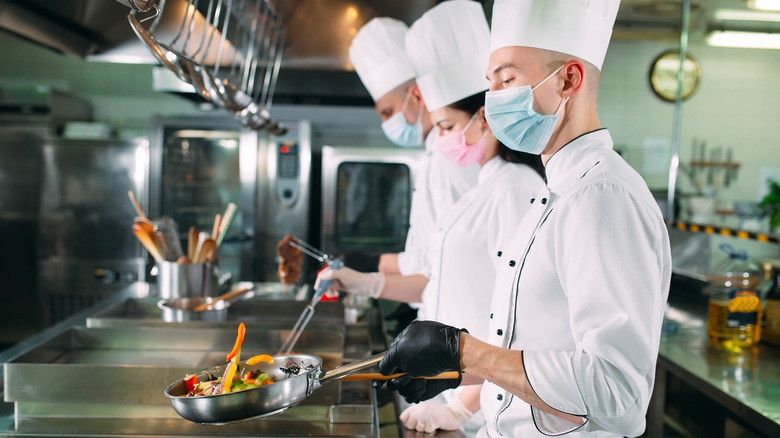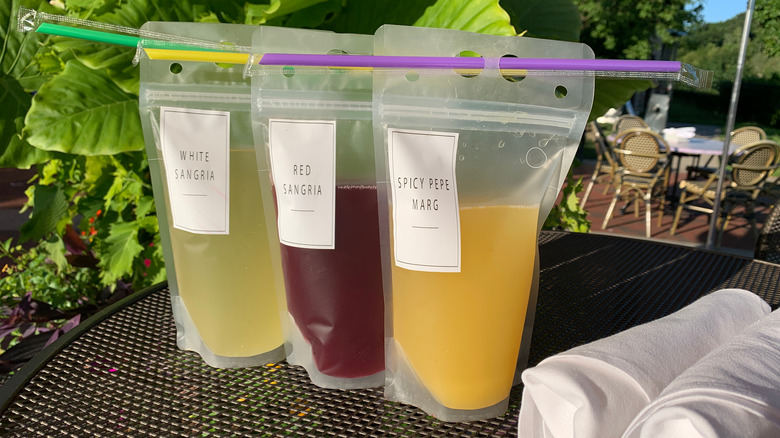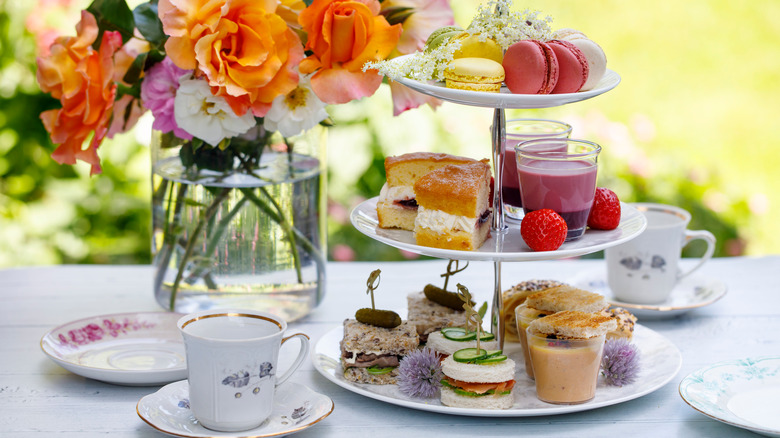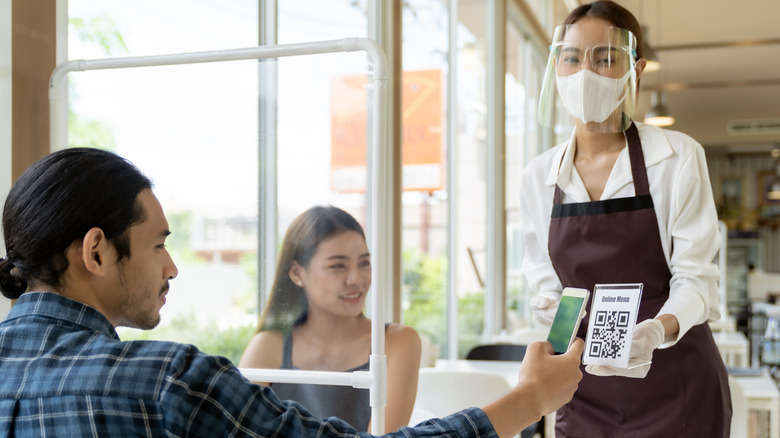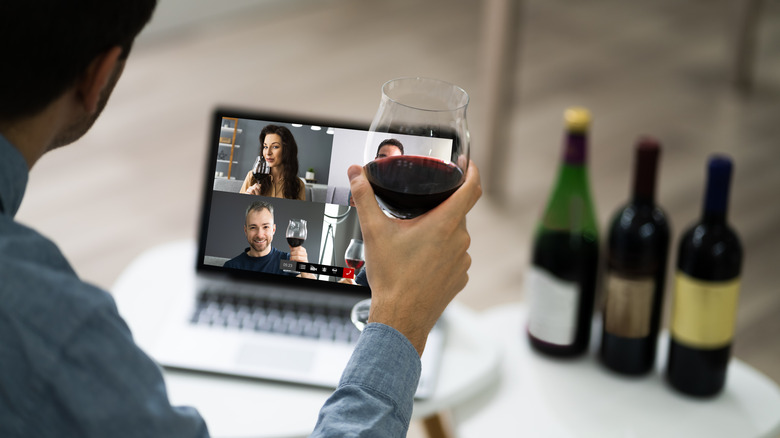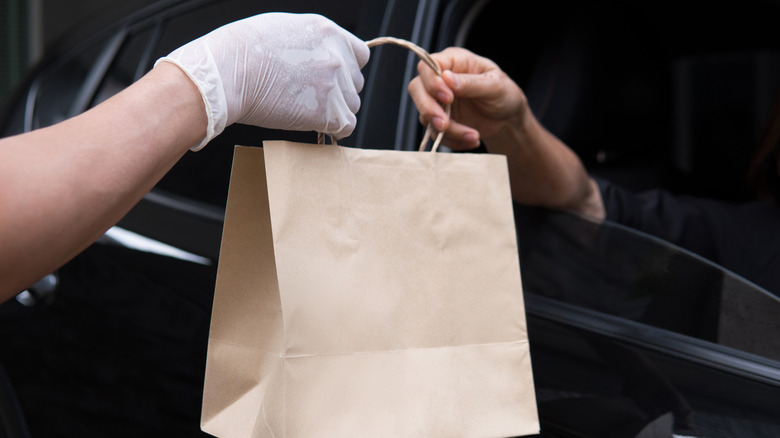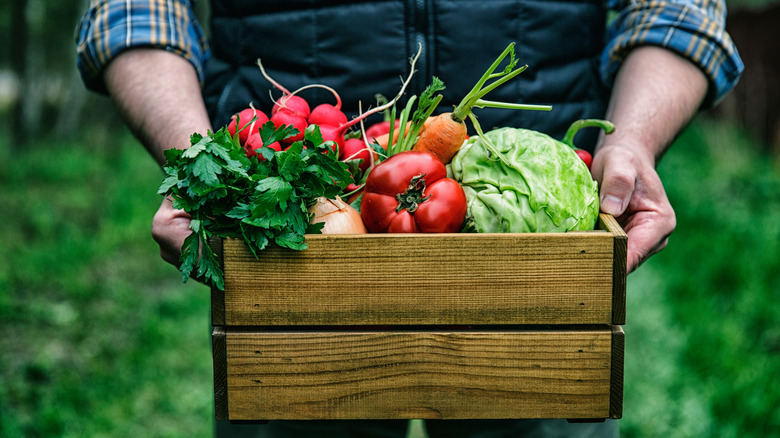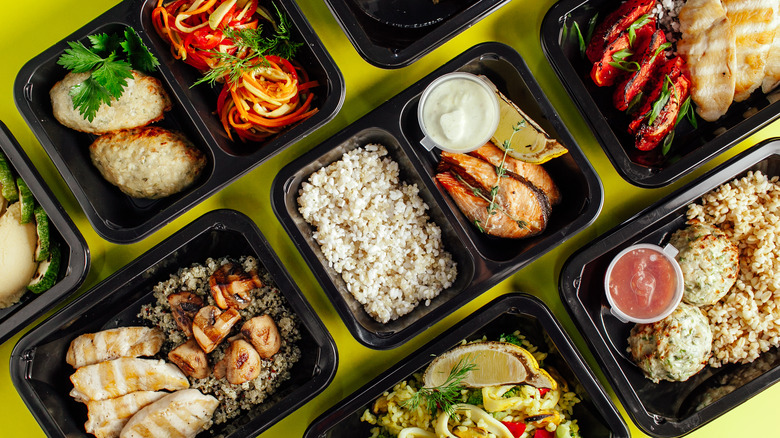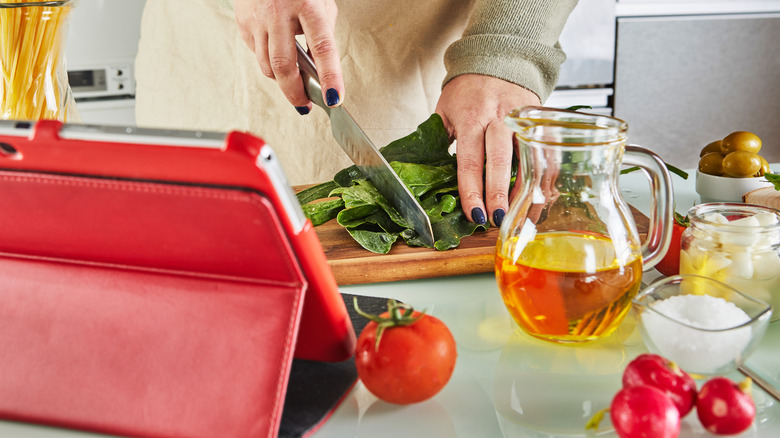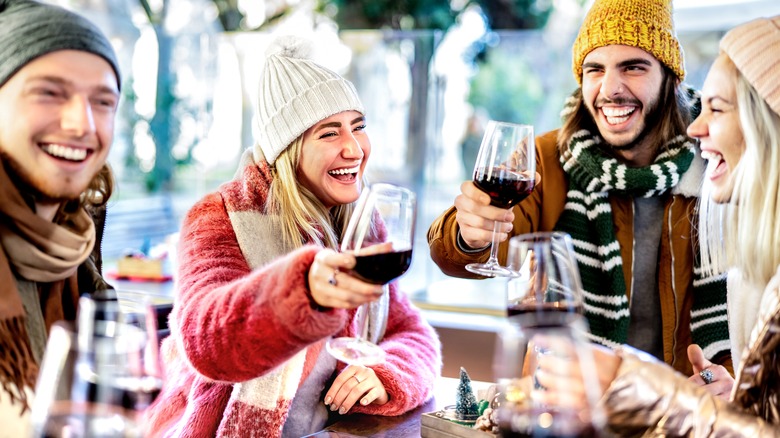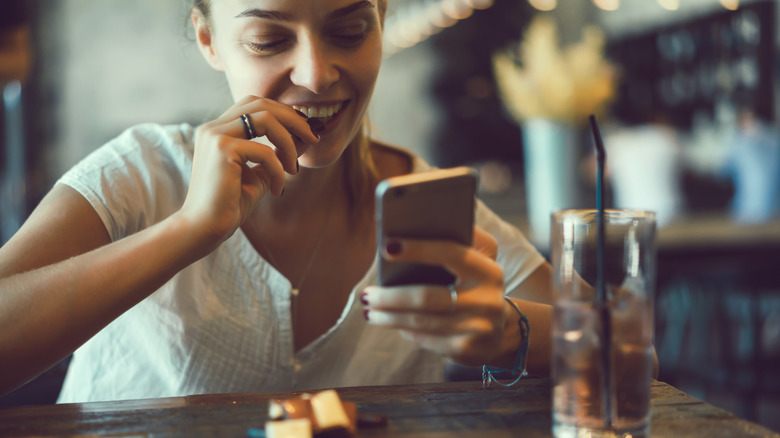How COVID Forced Restaurants To Prioritize Convenience
Few businesses were as impacted by COVID-19 as the restaurant industry. In order to survive, they had to shift gears creatively and act fast. With doors shut, having to let staff go, facing supply-chain issues, and dealing with the fact that much of the population was afraid to be in public, there were many wrinkles to iron out. As Deloitte stated in a 2021 report, "Similar to early pandemic trends, there are three main vectors at work influencing restaurants: convenience, digital, and safety. Of course, these catalysts overlap and influence each other greatly, but together they point toward a single, overarching mandate for restaurant brands to fundamentally change their business models."
Many of the adaptations restaurants made are here to stay — having no other choice, some of these unexpected changes have become the norm. Previously prohibited things like to-go cocktails and outdoor seating areas were pushed through and restauranteurs are fighting to keep them as part of their business models even after the pandemic shutdowns have ceased.
Getting creative with outdoor seating
When people started to avoid eating indoors — or in some cases, couldn't eat inside because indoor dining was banned — restaurant owners explored outdoor options. City restaurants that formerly were not allowed to have an outdoor area were granted exceptions. Governments began allowing seating areas to be built on sidewalks, streets, and even parking lots, garnering cute names such as parklets and streateries. Lights were strung, decorations mirroring the vibe of the inside were put up, and during colder months, they put up outdoor heaters, per The New York Times. It was a way for restaurants to stay afloat amid strict rules and a way for customers that didn't feel safe dining indoors to enjoy a night out
Many diners and restauranteurs alike have decided it should be kept this way. Many restaurants that have taken advantage of the relaxed laws and fines when it comes to outside seating don't want to return to the way things were. The New York Times reported that Catherine Mac Dowall and Michael Kerrigan, owners of the restaurant Naïve in downtown Louisville say that even after restrictions were lifted and inside dining was okayed at a smaller capacity, almost all their customers sat outside. "Why couldn't it have been easier before?" Mac Dowall asked. "Why did it take a pandemic for the government to allow people to eat outside?"
Will that be shaken, stirred, in a pouch, or plastic container?
Making a cocktail at home is always subpar compared to having a professional with a full bar make it. While regulars craved the ambiance of sidling up to the bar and chatting with their favorite bartenders, some opted for the next best thing during the pandemic.
Bar sales make up 20 to 25% of restaurant sales, according to Chron, so even with take-out food sales, restaurants were still in the red. So when to-go alcohol restrictions were lifted, this became a way for customers to support their favorite places and for restaurants to recoup some of their losses. This shift in liquor laws is the most significant change since Prohibition, according to The New York Times.
A to-go cocktail pales compared to a specially made drink at the bar, so mixologists and restaurant owners did their best to make it ceremonial. Packaging was done creatively, as seen at the Capo Deli in Washington, D.C., with their cocktail pouches, adorably named The Fauci Pouchy. Some even began canning their libations, such as The Cellar Peanut Pub in Iowa, per NPR. In 2020, 39 states allowed cocktails to go on a short-term basis, according to the National Restaurant Association. Now, 17 other states have permitted it permanently. Cheers to that.
Supper clubs and High Tea in lieu of regular dining hours
Everything changed for restaurants during the pandemic. Forced to close or work on a to-go basis only, many were forced to let staff go. When things began to ramp up again, former staff had moved on, and it became difficult to find help. Unable to operate normally, some restaurants got creative with things like monthly supper clubs and Sunday High Tea.
The Borland House in the Hudson Valley did both. Owner and chef Anna Frumes told Forbes, "restaurants will stay afloat in these interesting times by pivoting to innovative concepts such as weekly supper clubs or high tea in place of regular breakfast, lunch or dinner seatings." Old American Supper Club features guest chefs and unique themes. Then, every Sunday from 9-3, the parlor becomes a tea house serving three courses alongside high-end teas and wine. The best part is that Frumes only needs to staff Sundays and once a month on Saturdays.
In Delray Bech, Florida, during the height of the pandemic, when restaurants were closed or relying on takeout sales, one supper club helped support many local restaurants. "The Socially Distanced Supper Club" is a group created by John Brewer and Iain Paterson (via WPTV-TV). With a kind-of flash mob vibe, they put together a group of more than 1,600 people to share restaurant to-go deals, get together (at a safe distance), and help keep the businesses afloat.
The rise of QR code menus
No need to wipe down menus any longer: The QR code menu is king. "No contact" became the name of the game when restaurants began to reopen. Rather than flipping through the pages, guests simply scanned a code for their favorite eatery's menu. Not only does this limit cross-pollination of yuckies, but it is also more streamlined, alleviates the cost of printed menus, saves staff time, and leaves less room for ordering snafus. It's a win-win-win-win.
"It's going to be a preference for many customers, especially when it's an interactive menu that allows you to easily find dietary and allergy-related choices," Rom Krupp, CEO and founder of hospitality tech company OneDine, told CNN. No, the technology is not new: It was invented in Japan in the 1990s, but it reached new heights during the pandemic.
That said, this menu change isn't everyone's cup of tea. As outlets like the New York Post and The Washington Post have noted, some believe the QR code takes away from the dining experience.
Saying 'cheers' over Zoom
As World of Fine Wine reported in 2020, Zoom saw the potential for growth during the lockdown, and it benefited many businesses. The wine industry is a social space, and when group tastings and wine tourism were halted, Zoom saved the day. Virtual tastings became the norm, and even though regular life has somewhat returned, these tastings still have a place in the industry.
Wineries would send the wines in advance, and invitees would taste them along with winemakers. When Zoom fatigue set in, wineries got creative. Conduit Wine in Somerset, California, had previously been hosting blending classes where guests learn how to blend a cuvée, bottle it, and make a signature label. After COVID hit, they began sending all the tools to do it virtually. Social media platforms jumped on the bandwagon, too. You couldn't log onto Instagram without a banner popping up, "XX is going live with XX winery."
It wasn't just wine: Wisconsin Cheese went all out in 2021 with their virtual cheese tasting called "Cheesin' Around with Nick Offerman." The tasting, partnered with SXSW, was hosted by actor Nick Offerman. Participants received a cooler full of Wisconsin cheese before the event to taste, along with the "Parks and Rec" star and other cheese aficionados. All of these approaches offered a break from the "Groundhog Day" reality we were living in and gave us a chance to connect ... and maybe even slap on some lipstick.
At the drive-thru
When in-person dining was put on pause, eateries with drive-thru windows continued to do what they've always done: serve food to customers who never have to get out of their vehicles. Fast food was already poised to do well during these times, but the added convenience of the drive-thru window made them indispensable. According to CNBC, a study by the NPD Group showed that by December 2020, drive-thrus racked up 44% of off-premises orders. As CNN noted, McDonald's reported in 2020 that 90% of their sales were via drive-thru; Taco Bell also saw 5 million more cars go through the drive-thru during the same time period.
CNBC also notes that the increase in the importance of drive-thru ordering sparked even more competition between fast-food and fast-casual businesses. Chains like Sweetgreen and Shake Shack added drive-thru lanes, while companies already equipped increased the number of lanes. Chipotle Mexican Grill got cutesy by calling their expanded drive-thru lanes "Chipotlanes."
Arby's Chief Operating Officer John Kelly told CNBC that the pandemic prompted the company to focus more on efficiency by experimenting with artificial intelligence software and automated lanes and kiosks. "So they're not always trying to catch up on where the business is going, but actually get ahead of it," he said. "I think we've learned a lot of that during COVID, and we're going to keep that moving forward."
The farm comes to you
A restaurant is nothing without quality ingredients, and some of the best eateries get their produce, meats, eggs, and even dairy straight from local farms. The relationships forged between restaurant owners and farm proprietors are intrinsic, and farms suffered when restaurants closed their doors.
Some restaurants, however, found a way to support themselves and the farms they relied on by putting together farm baskets. For example, when Anna Frumes of The Borland House had to shut her doors, she put together farm baskets that were delivered weekly. Frumes told Hertelier, "I felt like I was building a new business every day — take out, pre-packaged meals, and farm baskets. I collected products from farms I like and curated them throughout our low season."
Similarly, when Chez Panisse founder Alice Waters had to close her Berkeley, California, restaurant, she didn't want the same fate for the farms she had forged a relationship with for almost 50 years. So waters put together a Sunday Market where she would feature a different farm each week. "It's our priority to take care of the farmers that provided for the restaurant over 49 years," she told Nosh.
This was a boon to the public as well. Everyone was cooking at home, and no one wanted to be inside a grocery store. This offered a symbiotic relationship for all, with a healthy bounty of food as a delicious reward.
Michelin stars at your door
Not being able to dine inside their favorite restaurants, patrons awaited their favorite meals on the couch. And so, more and more restaurants opted to add their names to delivery apps like Grubhub and DoorDash. Previously, the cost of participating in these apps was too high for most restaurants, but it became vital. Zachary Davis, the owner of The Glass Jar restaurant group in Santa Cruz, California, told MarketWatch, "We were effectively shut down. We closed for a couple of days, took stock, and realized it was the only way to keep our business open." Unsurprisingly, the major delivery companies' revenues skyrocketed in 2020.
Other companies saw the potential to cash in on the trend. Uber introduced Uber Eats, combining its driving services with food delivery. New companies like Slice, which delivers your favorite pizza, were also created.
It wasn't just casual restaurants that were utilizing delivery: High-end, luxury restaurants that had probably never thought delivery would be a part of their business model also jumped on the bandwagon. Many use different platforms, such as Tock and Caviar, to set themselves apart. Eater reported on several high-end NYC restaurants — such as Brooklyn Fare, run by Chef Cesar Ramirez, who decided to make his three-Michelin-starred Japanese and French menu accessible with a delivery menu divided into courses. Numerous other higher-end restaurants across the country offered similar delivery formats.
Famous chefs in your kitchen
Dining at your favorite restaurants wasn't possible for some time, so many people thought, "Why not learn how to cook your faves at home?" Classes were live or pre-recorded to benefit interested parties in different time zones. It was a way to break up the monotony in the comfort of their kitchens, but it became a real treat when esteemed restaurants got in on the movement.
Eataly in NYC, BLT Restaurants (with prestigious locations worldwide), and Distrito in Philadelphia are just a few spots that are brought their ethos and flavors to your table. Typically, the ingredients were sent to the attendees or a grocery list was sent beforehand. In addition, some combined wine pairings with cooking classes — Bravo Top Chef's Nini Nguyen hosted a cooking class paired with Silk & Spice Winery.
Some found ways to do good during bleak times. Socially Conchas is a Brooklyn-based company that teaches folks how to make conchas (Mexican sweet bread). They held virtual classes, matched 100% of proceeds, and donated them to support immigrant families. Others took the chance to provide positive messages along with their goodies. Baketivity produced a respite from non-stop chantings of, "I'm bored" as well as teaching valuable lessons with their baking kits. The kit includes mess-free ingredients, kid-friendly instructions, and fun activity books promoting positive conversations about diversity, inclusion, and kindness.
Aprés ski: Embracing the cold while dining outside
Eating outside wasn't a huge deal early in the pandemic; it was spring! But when winter reared its ugly head, the restaurant industry had to reinvent itself ... again. Igloos were bought and later returned after it was determined that they actually helped to spread COVID (via USA Today). Heat lamps were bought. Blankets were procured and showcased near outdoor tables. Some spots came up with themes to intrigue customers. For example, the Waverly Inn took a note from the French Alps, started an après ski program, and remained busy during much of the winter season, according to The Village Sun. It wasn't uncommon to see patrons donned in sporty sweaters, ear muffs, snow pants, and boots as customers who arrived in a full aprés ski attire received a glass of complimentary champagne. This perfectly coincided with aprés ski being the look of the fall and winter 2021 runway (via Harper's Bazaar).
Jeff Harding, beverage director at The Waverly, told Tasting Table how the concept came to be and said, "After the shutdown, I knew it was gonna be a rough winter. Friends mentioned ice theme fairs and après ski, where you dressed glamorously wintery. I partnered with champagne houses and fashion brands and did three runway shows outside The Waverly with winter wear, music, and models. It was so fun, and we had a packed house each time, even when it was about 30 degrees out!"
Pop-ups utilizing Instagram, Tiktok, and ghost kitchens
When businesses closed their doors and pivoted in new directions, many used social media to spread the word and take orders. Payments were usually made via Venmo. According to Adobe, when Harmonic Brewing filled its grounds with food trucks, it promoted it on Instagram. Customers ordered over DM, paid with Venmo, and then picked their orders up — a contactless process. Similarly, East Harlem Italian restaurant Rao's also began taking orders through their Instagram and had great success. As Insider noted, this allowed people to try food from the venerated establishment without a hard-to-get reservation.
TikTok is jumping on the ghost kitchen trend and opening locations across the country. With the SEO knowledge of what the public wants at their fingertips, they can hone in on what to serve. Plus, they already have a massive, captive audience. Ghost kitchens became popular during the pandemic as delivery and drive-thru became the norm. According to Insider, customers will be able to place orders for TikTok Kitchen through Grubhub. The raging success of Mr. Beast Burger should be a good indication of how Tiktok will fare. Created by YouTuber Mr. Beast, along with Virtual Dining Concepts, Mr. Beast Burger is a virtual restaurant brand that operates out of existing restaurant kitchens. This offers restaurateurs a chance to recoup some income, while the virtual restaurant can operate at a fraction of the cost of a brick and mortar.
